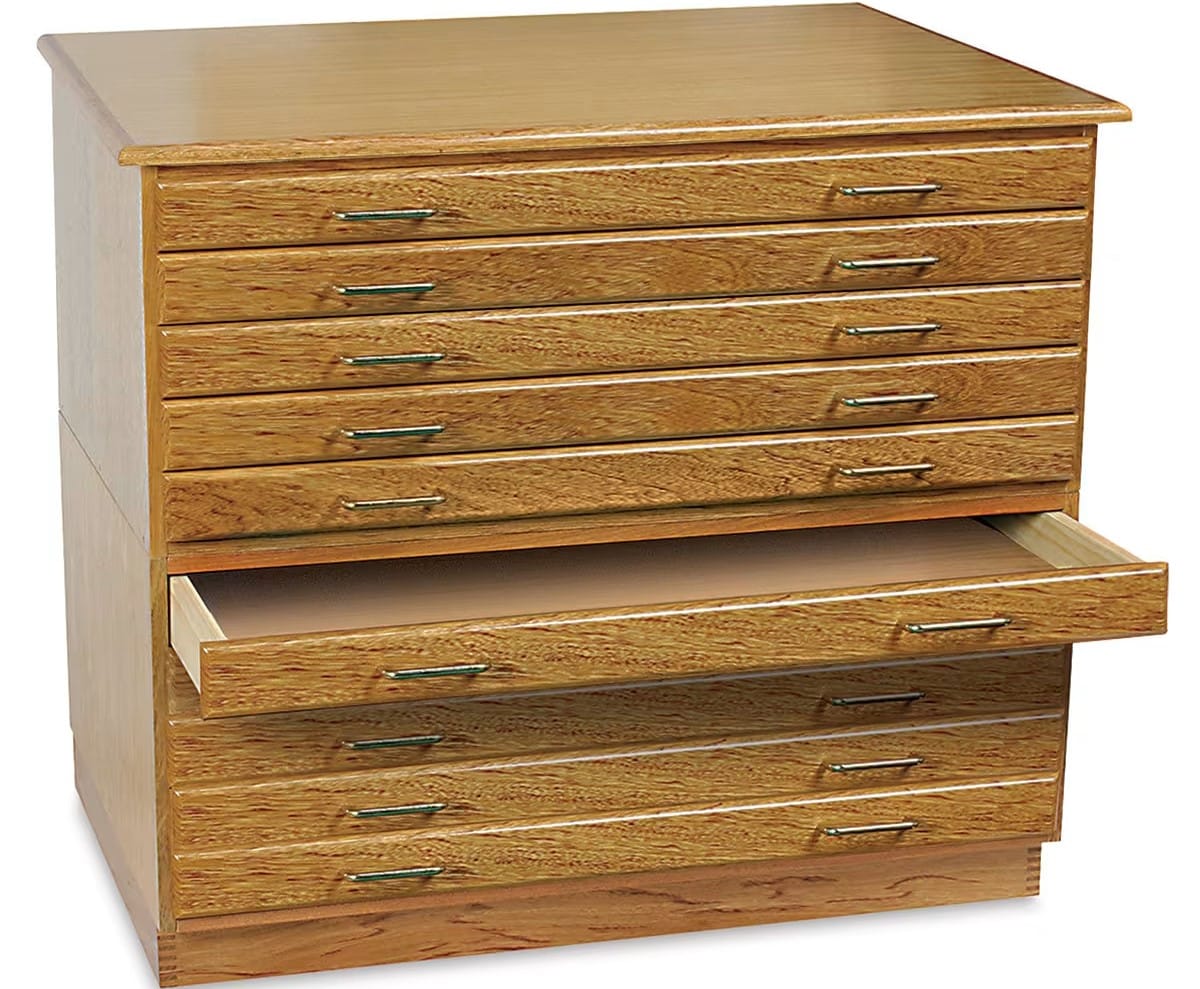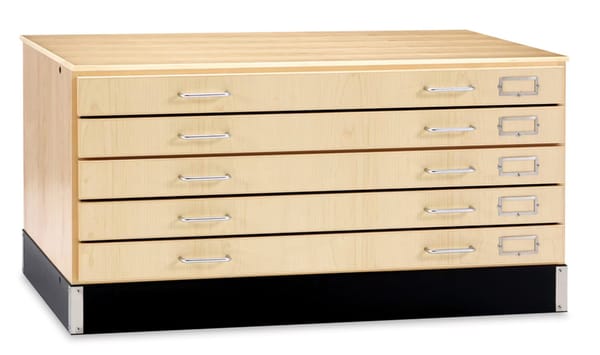Oak Flat Files: A Practical Guide for Artists, Studios, and Archivists
Learn how to choose oak flat files for art and archival storage. Strong, durable, and built to protect prints, drawings, and large papers.

Strong organization keeps paperwork flat, clean, and ready to show. Oak flat files add the warmth of real wood to that function, pairing archival-friendly drawers with furniture-grade durability that looks at home in studios, classrooms, galleries, and offices.
What Are Oak Flat Files, and Who Benefits Most?
Oak flat files are shallow, wide-drawer cabinets that store large sheets flat to prevent curl, dust, and light damage. They serve artists, printmakers, architects, photographers, and educators who need reliable, furniture-grade storage. The result is quick retrieval, safer handling, and presentation-ready work.
Core Advantages
- Even pressure across sheets prevents ripples and corner dings.
- Shallow drawer height limits stacking weight on delicate media.
- Furniture-grade oak integrates with client-facing spaces without looking industrial.
Typical Contents
Graphite and ink drawings, watercolour sheets, charcoal and pastel (sleeved), relief and intaglio proofs, screenprints, photographic prints, presentation boards, and plans.
Which Sizes, Drawer Counts, and Configurations Make Sense?
The best size matches your largest sheet plus sleeves and backers, then scales with stackable sections as archives grow. Common interiors fit 18"×24", 22"×30", and 24"×36" sheets. Five- and eight-drawer units often stack to 10 or 15 drawers without increasing footprint.
Dimensions and Capacity
- Interior height of ~2"–2¼" per drawer suits most papers and thin mounts.
- Depth and width should exceed the longest edge of your biggest sheet.
- Stackable sections let you grow vertically while keeping ergonomics stable.
Cases, Bases, and Stacking
A separate base lifts lower drawers to a comfortable height and away from floor dust. Stacking two or three sections creates a tall bank while preserving floor area. Alignment checks keep slides smooth across the whole stack.
Hardware and Slides
- Solid wood fronts with metal pulls deliver strength and classic aesthetics.
- Full-extension slides improve visibility and two-hand support under sheets.
- Smooth action matters more than sheer weight rating for paper archives.
How Do Oak Flat Files Compare With Steel Alternatives?
Both oak and steel flat files are used to guard paper, but the variances are in appearance, atmosphere, and maintenance expectations. Oak is publicly visible or mixed-use areas of a client that are sensitive to the presence. Rugged and high-traffic stores with an emphasis on dent-resistance and easy-cleaning are the places where steel performs well.
When Oak Shines
- Meeting rooms, galleries, and offices where finish enhances the space.
- Studios that double as presentation areas without feeling industrial.
- Long-term pieces that benefit from a timeless, warm aesthetic.
When Steel Excels
- Schools and production shops with heavy daily use.
- Maximum stacking in tight footprints with frequent cleanings.
- Budgets prioritizing durability over furniture-grade appearance.
What Archival Setup Inside the Drawers Prevents Damage?
A drawer becomes a micro-environment when lined, interleaved, and humidity-buffered correctly, thus preventing damage. Neutral materials and consistent orientation reduce abrasion, offset, and seasonal movement. Simple, repeatable steps produce long-term stability without slowing work.
Drawer Prep
Line bottoms with acid-free sheets or polyester films for a clean base. Add a rigid buffer board beneath liners to distribute point loads from stacks or folders.
Interleaving and Sleeves
- Glassine or archival tissue prevents surface transfer and scuffing.
- Polyester sleeves stabilize friable media such as charcoal and soft pastels.
- Consistent “heads one way” orientation speeds careful pulls and returns.
Humidity Management
Small rechargeable desiccant packs at the rear help hold steady conditions. Seasonal regeneration is usually enough; aim for stability rather than a single perfect number.
Where Should We Place Oak Flat Files, and How Should They Be Used?
Placement and daily habits influence longevity as much as build quality. Keep cases level, out of the sun and HVAC blasts, and leave space for full extension and a staging table. Calm handling and capped drawer loads preserve edges and rails.
Placement and Ergonomics
- Avoid direct sun, radiators, and vents that cause cycling.
- Leave room for full drawer travel and two-person access.
- Level the base; uneven floors can rack cases and misalign slides.
Handling Habits
- Support sheets with two hands at midpoints, not corners.
- Stage pulls on a clean table rather than the cabinet top.
- Stop filling before insertion meets resistance.
Which Finishes and Construction Details Matter in Oak Cabinetry?
Finish and joinery determine how well the cabinet resists scuffs and holds alignment. Solid fronts, durable clear coats, and square cases maintain smooth slide action for years. Label-friendly fronts make indexing fast and reduce unnecessary tugging.
Wood, Finish, and Joinery
- Solid oak fronts with matching veneer cases provide strength and continuity.
- Durable clear coats wipe clean and resist everyday marks.
- Tight joinery and squareness keep drawers running true.
Pulls and Labeling
Brass or coated pulls feel secure in frequent use. Integrated label frames or flat, label-friendly fronts make organization intuitive and quick.
How Do Assembly and Shipping Affect Your Choice?
Many wood flat files are unassembled to reduce freight risk and cost. Assembly is straightforward with basic tools and a second set of hands. Careful receiving and leveling deliver the long, smooth glide you expect.
Receiving and Assembly Tips
- Inspect cartons and photograph damage before opening.
- Assemble on a padded, level surface to protect the finish.
- Install base, stack sections, then fine-tune alignment and level.
Moving and Long-term Stability
Move sections separately; never lift filled drawers. Re-level after moves to maintain smooth extension and consistent gaps.
What Maintenance Keeps Oak Flat Files Performing for Decades?
Light, regular care of flat fileswatercolour prevents small issues from becoming expensive repairs. Wipe, vacuum, and re-level on a predictable schedule. Replace liners, refresh desiccant, and update labels during annual audits.
Quarterly Checklist
- Wipe fronts and pulls; dust tops and toe spaces.
- Vacuum inside rails and corners with a soft brush.
- Check labels and mirror updates in your digital index.
Annual Checklist
- Refresh desiccant; replace worn liners and folder stock.
- Re-level cases; buildings settle and floors shift.
- Review contents for duplicates and rehouse odd sizes.
Where Can Oak Flat Files Fall Short, and How Do You Mitigate?
Trade-offs include weight, finish sensitivity, and a higher cost than basic metal. Sensible care and setup minimize these concerns. The payoff is decades of function with a welcoming, furniture-grade presence.
Common Trade-offs
- Weight requires two people for safe positioning.
- Harsh cleaners can dull the sheen; use mild agents.
- Upfront cost exceeds many steel options.
Simple Mitigations
Felt pads under tools, coasters for beverages, and a microfiber routine preserve the finish. Buy once, care lightly, and expect long service.
How Do You Label, Index, and Retrieve Efficiently?
Clear labels and a mirrored digital index speed critiques, framing days, and loan paperwork. A simple routine prevents mystery gaps and repeated handling. Consistency keeps the cabinet productive, not just pretty.
Labeling and Digital Mirrors
- Label by size, medium, client, and date range in large type.
- Mirror the layout in a cloud spreadsheet for quick search.
- Add condition notes and loan fields with return dates.
Fast Retrieval Routine
Keep a “returns” drawer for in-progress projects, then re-file weekly. Photograph outgoing works for condition records and inventory updates.
Final Word
Oak flat files combine the archival logic of flat storage with the presence of real wood furniture. Thoughtful sizing, neutral liners, and predictable routines keep drawings, prints, and plans exhibition-ready while the cabinet elevates the room. Specify once, maintain lightly, and expect a long, reliable life function and finish working together every day.
Frequently Asked Questions
Are Oak Flat Files Archival or Mainly Decorative?
They are archival because they store sheets flat, limit stacking pressure, and allow neutral liners and sleeves. The wood case simply provides a warmer, furniture-grade presentation.
How Many Drawers Should a First-Time Buyer Start With?
Five drawers cover most active projects and keep loads light. Add another stack as archives grow to avoid overfilling and pressure rings.
Can Mounted Works Live Beside Loose Sheets?
Separation is safer. Store mounted pieces in dedicated drawers or rigid folders to prevent imprinting and abrasion on neighboring sheets.
Do Wood Cases Need Special Climate Control?
Steady, mid-range humidity benefits both paper and wood. Avoid sun and vents; stability matters more than chasing a single number.
Is Assembly Difficult for Wood Flat Files?
Most arrive with clear instructions and standard hardware. With two people and careful leveling, assembly and alignment are straightforward.




